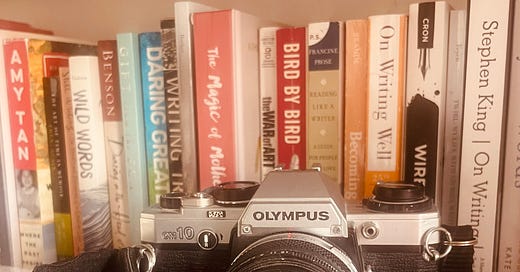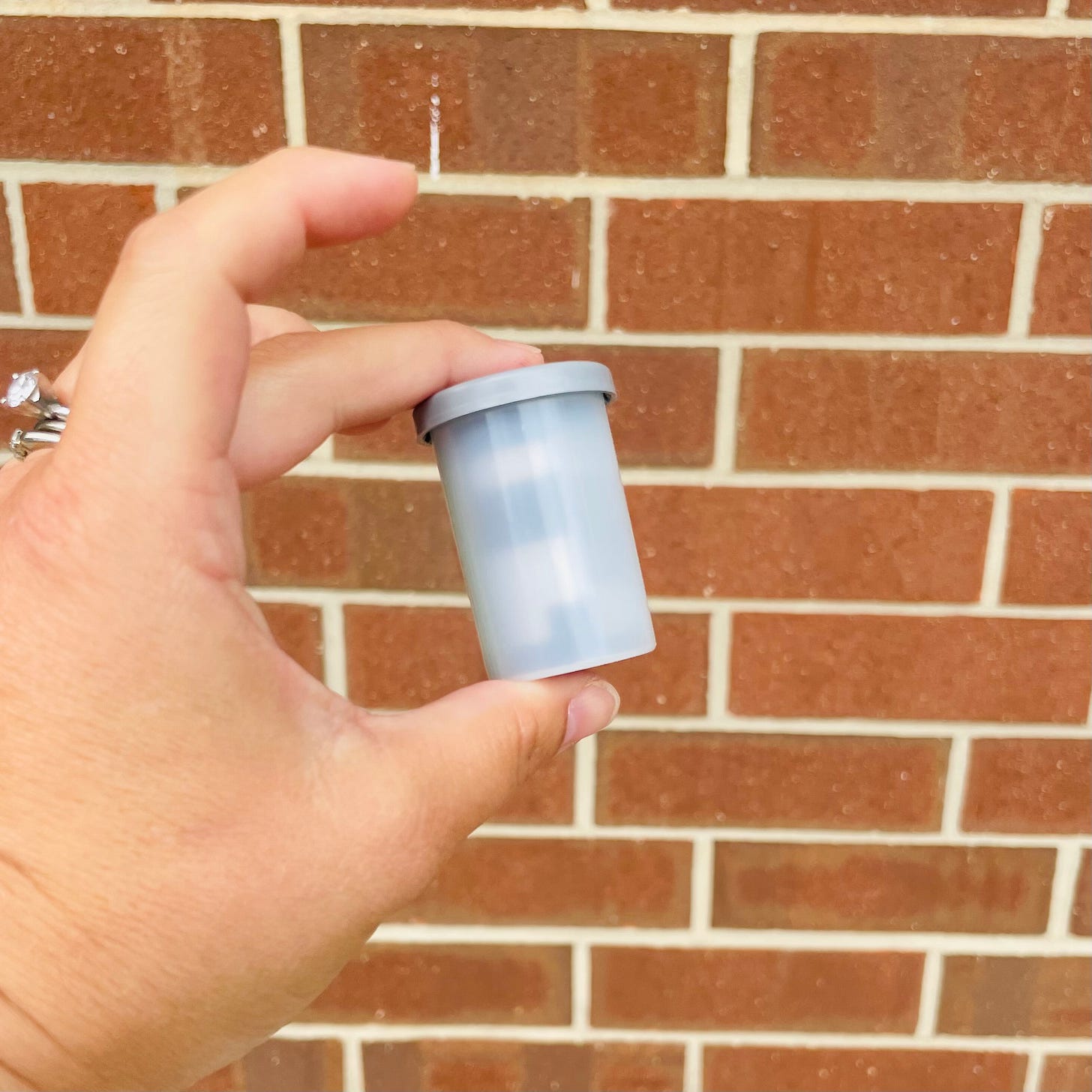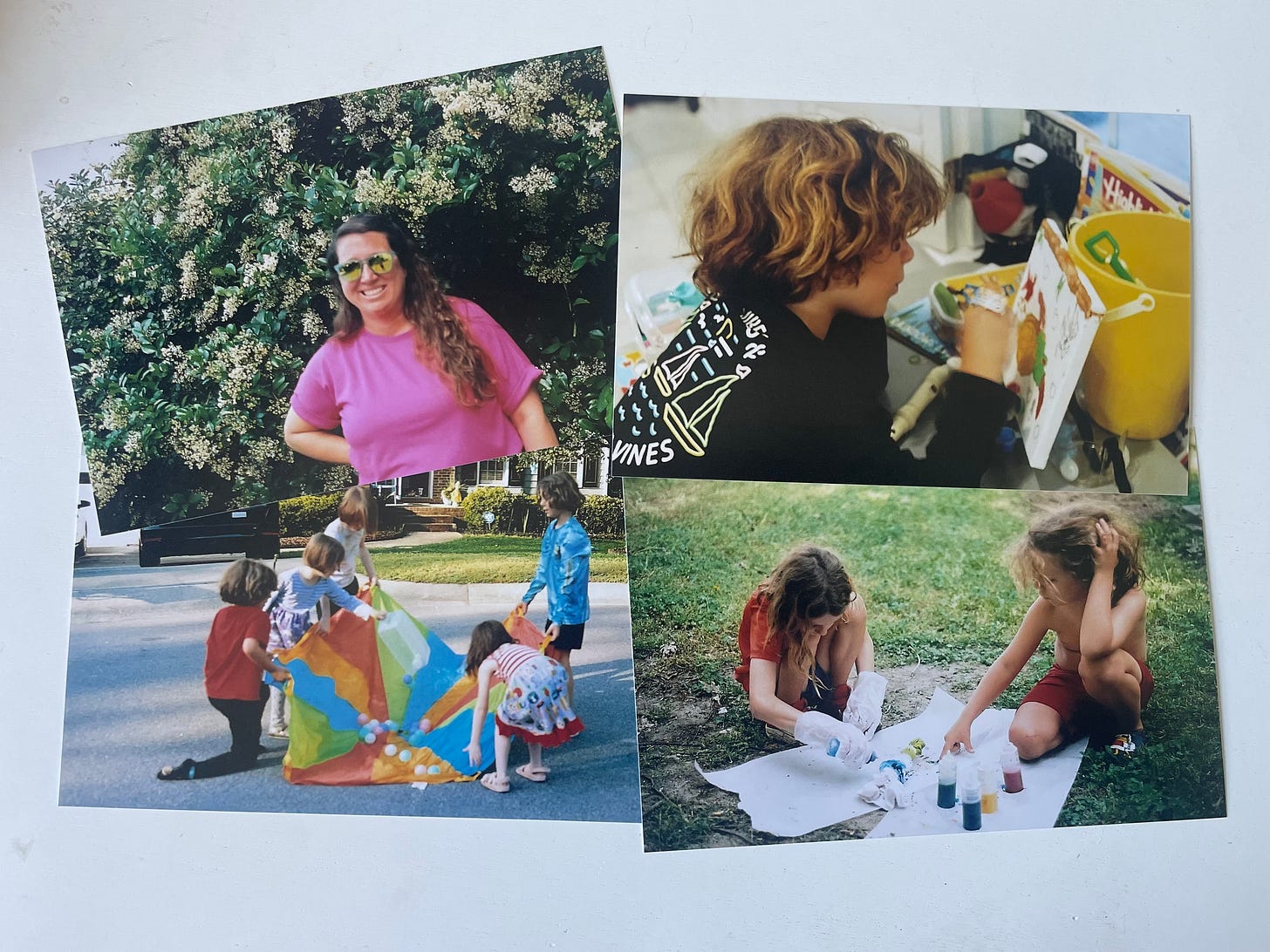I guess it’s not technically the first roll of film I’ve ever shot. I remember dropping rolls of film off at Eckerds as a child in the ‘90s. I’d carefully write my name and home phone number on the envelope before handing over the little plastic container of film full of pictures I’d taken on my plastic Kodak camera on vacations or at summer camp.
When the film was ready, it was always a surprise: what did I deem important enough to take pictures of? Sometimes the photos were fuzzy, or a finger was blocking part of the photo, or someone’s head was cut off. My childhood photography was pretty average, but I always got a thrill out of opening the envelope and flipping through the prints to find memories I’d managed to capture in the frame.
But then, there came the digital camera. And the iPhone. And so for a long time, my photos have been digital. I do have a stack of printed photos in a drawer—there’s no real rhyme or reason (or organization) to the ones I’ve printed out. Just a handful here and there as I’ve needed printed photos to hang on the walls, for school projects, or for gifts. Most everything, though, lives in that mysterious land of the cloud. And organizing my camera roll with its 56,508 photos (a number that is constantly growing) is one of those projects that is always hanging over my head.
So maybe the reason I was intrigued by film was the simplicity of it? 36 exposures; no room to take 30 different photos of the same thing, and then forget to go back and delete 29 of them.
Or maybe it’s that I’ve always had a bit of a fascination with nostalgic things. In my twenties, I worked hard to transfer my Diet Coke addiction to sparkling water and ditch soda altogether, but if you offer me a Coke in a glass bottle, the answer is always yes. I love browsing the aisles of a thrift or antique store and lingering when I come across old, fascinating things. A typewriter is high on my wish list. Film fits right in.
I’ve watched the resurgence of film’s popularity with photographers, but I’m a complete and total amateur, so while it seemed cool, I didn’t think it was for me. But when I saw the listing for a 100 Days of Summer on Film workshop through Exhale Creativity (and the helpful disclaimer that anyone could do it—not just photographers), I started thinking, “maybe film could be for me.”
The only problem? I didn’t own a film camera.
I browsed online some, debating over some cute vintage-looking modern options, but before I hit “add to cart,” I put out a call in my Buy Nothing group.
“Anyone have an old film camera lying around?” I posted. “I’d be happy to take it off your hands.”
A couple of hours later, I got a notification. “I have one I’d be willing to let go of. Send me a DM.”
I chatted a little with the commenter over DM, and she shared that she had a film camera that had belonged to her dad. It had been sitting in a box for years, but she’d held onto it for sentimental reasons. “He’d want it to be used, though,” she told me. Having lost my own dad over a decade ago, I felt honored that she’d share this tangible form of memory with me.
I made arrangements to pick up the camera, and once it was in hand, read through the manual, watched a helpful YouTube tutorial, and loaded it with fresh batteries and film. And then I was ready to shoot.
A few weeks later, when I dropped off my first roll of film at a local camera store, I must have looked a little insecure. The guy helping me asked, “Are you nervous?”
I was, a little. I didn’t know if a single one of the photos on the roll of film would turn out. But also, I felt a little bit like an imposter in this camera shop, filled with people who know things about photography.
My camera roll is FULL, sure, but there is no real technique to the thousands and thousands of photos I’ve taken of my kids. I know a tiny bit about ISO and aperture, but what I do know is only a drop in the bucket compared to what I could know.
I’ve gone through The Artist’s Way quite a few times in the last few years, as
and I have led creative cohorts of women through it, and one thing that’s really stuck out to me is the concept of giving yourself permission to be a beginner.I didn’t really have words to put to why that concept has been so impactful to me, but a few weeks ago, I listened to an episode of the 10 Things to Tell You Podcast, and a section on perfectionism really caught my attention. I don’t consider myself a classic perfectionist, but I’m learning that perfectionism can show up in sneaky ways.
The host,
, shared a message that she has internalized: “You only do things that you're good at and can be awarded for or can be recognized for.”A little lightbulb went on in my head when she said that. Then she went on to say that this belief had (incorrectly) taught her:
I don’t know what, exactly, gave me the belief that I should only do things I’m already good at. I tell my kids that practice makes perfect, and it’s not that I’m not willing to learn (I love to learn!), but I do tend to stick to things that feel more “in my lane.” I can try new things, as long as it feels like something I could be good at. (So, you won’t find me, with my complete lack of rhythm and coordination, dancing on social media.)
Taking photos on my phone is one thing, but taking photos on film—who did I think I was? Certainly not a real photographer. I had a sense that if I was going to invest in something, I needed to be good at it. My beginner’s interest in film photography was competing with the question: What was the point of paying good money for film and developing when I could take photos for free on my phone or digital camera?
When I got the prints back, some of the photos were terrible—fuzzy and out of focus.
But others, I felt great about for my first roll of film.1 (Photo credit for the top left goes to my six-year-old).
While it’s nice to have some additional photos printed out, this roll of film wasn’t really about the final product.
It’s about the fun I had taking the photos. The way it made me think differently—slow down and pause. My typical photo strategy of clicking as many times as I can in 20 seconds, hoping for a great picture somewhere in the two-dozen almost identical images, doesn’t work with film.
Film made me stop and think. Separate the act of taking the photograph from the end result. With a digital camera, the photos are unlimited. With a roll of film, I need to consider why a particular moment is worth using one of my 36 exposures.
When I have my film camera in hand, I’m paying more attention to the light and the details. I’m noticing the moment and examining my surroundings as I try to figure out the camera settings. I’m more intentional about when I click. I’m thinking about what exactly it is that I want to remember about the moment.
And then… I have to wait. First, to finish the roll of film. Then, to get it developed.
And there’s something beautiful about practicing the art of waiting in our world of instant gratification.
* Some links may be affiliate and earn me a few pennies at no extra cost to you!
I’m not sharing some of my VERY favorites because I’m constantly re-evaluating what I share of my kids on the internet, and right now I’m (mostly) trying to avoid faces. If this is you, too, tell me what boundaries you’ve landed on! And also, check out this Embracing Mystery photography guide by my friend
that has some great prompts for not showing faces.








I love this! (And not just because you've quoted me here.) I've long struggled with the idea of doing ANYTHING for fun, without attachment to an outcome. This is such a good reflection on the joy of trying things...I think is something that we subconsciously miss about childhood.
I joined the workshop for many of the reasons you did! I am still waiting to get the film I ordered in the mail, so I haven’t taken any pics yet. Excited to be a beginner with you this summer!